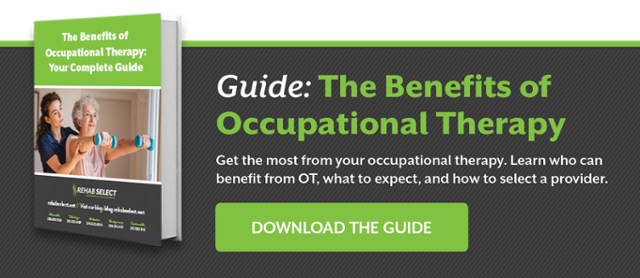
Chronic illnesses, sudden injuries, and mental and physical disabilities can make it difficult or even impossible for those suffering from them to perform many of the day-to-day functions most people take for granted.
The Field of Occupational Therapy
The field of occupational therapy is focused on the remediation of impairments and limitations to everyday life. While this often involves one’s occupation in the sense of a job or career, it can also refer to an occupation in the broader sense of how someone occupies their time, including academic endeavors, hobbies, and social activities.
While occupational therapists may, like physical therapists, work to help patients increase strength and flexibility to minimize impairments, they also help patients learn practical techniques to work around the difficulties imposed on their lives by those impairments. The goal is to maximize their ability to do what they want and need to do despite these issues, thus increasing day-to-day function and independence.
Typically, patients for whom occupational therapy is recommended are recovering from surgeries (especially joint replacement and other orthopedic surgeries), rehabilitating after a stroke or cardiac event, or regaining mobility and function to chronic health conditions.
Understanding the objectives of occupational therapy, including examples of occupational therapy goals, helps patients and their families achieve the best outcomes.
While occupational therapy is available for children as well as adults, we’ll examine examples of occupational therapy goals for adults. These examples will also help illuminate how occupational therapy is different from physical therapy, a closely related field with which it is often confused.
How Is Occupational Therapy Different from Physical Therapy
Occupational therapy is often confused with physical therapy because the two fields do share many similarities. However, there are important differences between occupational therapy and physical therapy. In general, the primary difference between occupational therapy and physical therapy is that physical therapy focuses on the ability of a patient to move their body, while occupational therapy focuses on the ability of patients to engage in day-to-day activities. Therefore, while occupational therapy goals may involve many of the same goals as physical therapy, the objectives of occupational therapy tend to be broader and more holistic than those of physical therapy.
SMART Framework for Goal Setting
Many occupational therapists, like many other goal-focused professions, adhere to the SMART framework for setting goals. Under this framework, a SMART goal is:
- Specific
- Measurable
- Achievable
- Reasonable
- Timely
It is important to keep this framework in mind when considering examples of occupational therapy goals for adults. Many of these goals may seem rudimentary or painfully simple to those without a significant impairment; however, based on the achievable and realistic elements of the SMART framework, such goals are perfectly appropriate and serve as good examples of occupational therapy goals for adults to illustrate the SMART framework in action.
12 Examples of Occupational Therapy Goals for Adults
Occupational therapy is broader than the related field of physical therapy. Occupational therapy includes cognitive as well as physical goals with the aim to improve daily functioning. The examples of occupational therapy goals for adults listed below illustrate the kinds of activities that might be included in an OT treatment plan.
Cognitive
- 1. Remembering a List – Restoring and maintaining memory are key goals for cognitive occupational therapy.
- 2. Learning Nonverbal Cues – For patients with cognitive impairments, such as autism, learning social cues is an important step along the path to developing meaningful relationships.
- 3. Practicing De-Stressing Techniques – Setting a goal to meditate or practice mindfulness at least once per day or several times per week can help with the stress of occupational therapy and the underlying impairment.
- 4. Improving Attention Span – This goal can be measured by time spent engaged in an online lecture, reading a book, or holding a conversation.
Physical
- 1. Grasping – Grasping objects is key to many everyday activities and requires not only hand strength but coordination and dexterity.
- 2. Prolonged Standing – The ability to stand for increasing lengths of time is a major goal for many occupational therapy patients.
- 3. Walking – The logical goal to follow prolonged standing is independent walking.
- 4. Improving Hand-Eye Coordination – A variety of exercises exist to train and measure the ability of patients to make their hands go where their mind intends them to.
Functional
- 1. Dressing – Dressing requires a certain level of stamina to stand or sit up as well as dexterity.
- 2. Independent Dining – Independent dining can include cooking a meal for oneself as well as the ability to feed oneself.
- 3. Independent Use of the Restroom – Impairments often mean a loss of privacy. Independent use of the restroom is a key sign of regained independence.
- 4. Finding Employment – For many occupational therapy patients, this is the ultimate goal: being able to successfully secure and maintain long-term employment.
The above examples of occupational therapy goals for adults may seem modest to those without significant physical impairment; however, achieving these and similar goals can make a tremendous difference in the level of independence and everyday quality of life experienced by those with such impairments.
Help is Available
The objectives of occupational therapy will be different for every individual. At Rehab Select, our certified occupational therapists work with a comprehensive team to design a therapy program that is customized to the individual. To learn more about how occupational therapy can enhance the lives of adults with a variety of impairments, schedule a tour with Rehab Select today.




